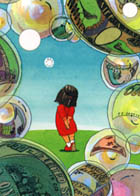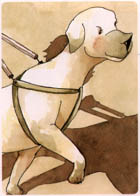IF I HAD A TRILLION YEN . . .
Bestseller Brings Used-Up Money to Life
November 29, 1999
 |
|
The book urges people to think about the price of cleaning up Japan's economic bubble. (Yuko Hamano, Ryu Murakami, Shogakukan)
|
|
Since the bubble economy's collapse in 1990 the media has been peppered with references to "bad loans," and literally trillions of yen of public money--sums too enormous for people to comprehend--have been injected into ailing financial institutions. In summer 1999 a book was published that sets out to put these unrealistic sums into perspective. Ano Kane de Nani ga Kaeta ka (What Could We Have Bought with That Money?), published by Shogakukan, uses text and illustrations to suggest how else those trillions could have been used.
The Wonders That Can Be Done
What could be accomplished, for example, with the 500 billion yen (4.8 billion dollars at 105 yen to the dollar) in public funds that were used to shore up a major Japanese bank? Some 20,000 visually impaired people in Japan are waiting to have guide dogs; since training a guide dog costs 23 million yen (219,000 dollars), 20,000 of them could be procured with 460 billion yen (4.4 billion dollars). Japan's Marine Science and Technology Center spent 12.5 billion yen (119 million dollars) to develop the Shinkai 6500 deep-sea probe, in use since 1989; one more unit could be built to offer deep-sea cruises to the public. The cost of constructing a recycling plant in Hokkaido for batteries and other waste material containing mercury was 100 million yen; similar plants could be built in all 47 prefectures with 4.7 billion yen (44.8 million dollars).
|
 |
|
Guide dogs are one item on Murakami's list. (Yuko Hamano, Ryu Murakami, Shogakukan)
|
Even after spending all this money, 22.8 billion yen (217.1 million dollars) would be left over--enough to buy the copyrights for all Beatles songs, finance the World Wide Fund for Nature's activities to preserve African elephants for a full century, and acquire the world-renowned piano manufacturer Steinway & Sons.
There are 40 shopping lists in the book, containing a total of 122 items. Seeing concrete examples like these gives readers a real idea of just what an extraordinary amount of public money is contained in those numbers.
The Importance of Knowing
The author of the book is Ryu Murakami, a winner of the Akutagawa Prize--one of Japan's most prestigious awards for emerging writers, considered a gateway to prominence. Murakami has a broad-based readership but is particularly popular among young people. Asked why he dared to tackle such a weighty subject using pictures, he said, "If I write about serious, gloomy subjects using only text, it would make the readers gloomy. Also, I wanted to make it as accessible as possible." Murakami chose a 20-year-old art student who attends college in Kyoto as the book's illustrator.
This approach has proven successful: The book has already sold over 180,000 copies, and, unusually for an economics book, it has been especially popular among women. It has also been featured in the foreign media, including the Associated Press and Newsweek.
The greatest moral of Murakami's book is the importance of knowing, because knowing is the first step toward being able to think independently about the world around us. Juxtaposing strange shopping lists with charming illustrations, his work certainly drives home the severity of Japan's post-bubble economic troubles.
 Edited
by Japan Echo Inc. based on domestic Japanese news sources. Articles presented
here are offered for reference purposes and do not necessarily represent
the policy or views of the Japanese Government.
|




















